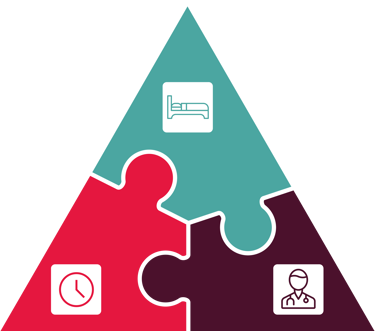Hospital at Home
Hospitals at home, also known as Virtual Wards, are the game-changing solution the NHS has been looking for and technology partners are essential to their success.
Let us collaborate with you in advancing healthcare practices and empower you to deliver outstanding, safe, and efficient remote care to your patients.
What is a Hospital at Home?
Hospitals at Home and Virtual Wards are a practical alternative to traditional care models, capable of solving many of the problems that impact health and care providers today.
Through the help of cutting-edge remote monitoring devices and communication tools, hospitals at home enable people to be cared for and recover in the comfort of their homes.
Treating people this way not only improves outcomes by lowering their risk of readmission and promoting a faster recovery, but it also reduces overcrowding in hospitals and alleviates pressure on health and social care staff. As a result, Trusts and ICBs incur less costs and have more time to focus on people with urgent care needs.
It’s thanks to these innovative, forward-thinking solutions that clinicians can now deliver frictionless community care to people at home, safely and efficiently, at any time.
While Hospitals at Home and remote care models are becoming widely implemented across the health and social care sector, as with any relatively new advancement, there can be challenges to overcome for them to work optimally. Read more about the challenges of Virtual Wards and how we can help you overcome them.

Spearheading Innovation to Support Patients and Care Providers
We live in an era dominated by digital, but despite advancements in technology, there continues to be a problematic divide between primary, secondary, and social care and a lack of digitisation across health and social care as a whole. We’re the only supplier that can bridge this gap between you and these sectors, all of which are needed to make hospitals at home work efficiently.
ICBs all over the UK are choosing Access solutions for their simplicity and ability to integrate seamlessly with existing systems and processes. Our remote patient monitoring (RPM) solutions ensure your staff have constant visibility of patient data, equipping clinicians with all the information they need to deliver acute-level care to people at home.

Solutions That Make a Difference
Our state-of-the-art software features user-friendly dashboards that capture data and provide clinicians with a comprehensive, real-time view of patients’ health statuses, empowering you to make the right decisions about their care.
Whether you’re operating a step-down model to free up hospital bed capacity or implementing an anticipatory care plan for proactive intervention, our solutions enable you to roster, provision, and monitor care, ensuring all your care delivery needs are covered.

The Core Components of a Hospital at Home
-
RPM Support – Combines remote clinical observations with daily living activities to provide clinicians with real-time data and alerts of a person’s health.
-
Transfer and Discharge Management – Brings all the necessary elements of a care package together and allows you to monitor the progress of care, enabling faster transfers and discharges.
-
Bed Management and Patient Flow – Utilises clinical workflows to provide a real-time view of RPM data alongside other health information. Clinicians are able to manage and assign beds for both physical wards and for Hospital at Home.

How Hospital at Home Enhances Healthcare
£bn
potential saving every year
%
of people cared for at home felt more confident about being able to manage their condition
%
reduction in re-admission rate
%
reduction in the average length of hospital stay

Learn how virtual wards can create better outcomes for patients and healthcare providers!
Bringing the Hospital Home Through Actionable Insights
Electronic Patient Record (EPR) System:
Central record to hold patient information for healthcare professionals
Social Care Case Management:
Central record to hold patient information for social care professionals

Care Planning:
Central record to hold patient information for care professionals
Patient Flow Manager:
Dashboards that show an overview of patients and their needs in each virtual ward
Monitoring Solution:
To show how patients at home are doing
Care Commissioning:
To ensure everything needed for the care plan is in place
Rostering Software:
To ensure the right people are in the right place at the right time

Social Prescribing Software:
To help solve social issues that can lead to hospital admission
Strengthening Hospital at Home Care Approaches Through Integration
To ensure Hospitals at Home work effectively, systems, people, and places all need to collaborate and communicate with each other. Access’ suite of integrated solutions ensures workflows across acute, community, voluntary, and social care are seamless and efficient, supporting comprehensive, coordinated care.

How We Support Hospital at Home models
Hospitals at home and Virtual Wards are transforming healthcare as we know it. Find out more about how they work, the advantages for everyone involved, and how Access supports their implementation and success.
Why Hospital at Home?
-
Enables a consistent user experience
-
Adaptable to various clinical pathways
-
Leverages existing capabilities for efficiency and clinical adoption
-
Effortless integration with health and social care systems
-
Based on a common data model

Benefits of Hospitals at Home for:
Frequently Asked Questions
What is a Hospital at Home in the UK?
Hospital at Home is a type of care that delivers hospital-grade care to patients within the comfort of their own home. The service is designed for those with less hands-on care needs. It is delivered by a team of specially-trained staff (a multi-disciplinary team) who work closely with each individual and their clinicians to develop personalised treatment plans according to their care needs.
Throughout the person’s recovery, they remain under the constant supervision of their hospital consultant until they are deemed medically fit for discharge.
What is the difference between Hospital at Home and Virtual Wards?
Hospital at Home and Virtual Wards are both terms used by NHS England to describe remote monitoring and technology-enabled care models, as well as face-to-face visits from clinical teams.
While Hospital at Home is the term most commonly used in Scotland and overseas and can take a slightly different approach to the delivery of care, the objectives of both models are the same – to provide a safe, person-centred alternative to inpatient care.
Can a hospital force a patient to go home?
According to clinical law, a hospital can indeed force a person to leave if they no longer require medical care that necessitates hospitalisation. While some individuals may resist discharge due to personal reasons, the courts have supported hospitals in reclaiming beds for those in need of more urgent treatment.
If a person refuses to leave despite not needing to stay, the hospital must demonstrate that all reasonable efforts have been made to arrange appropriate alternative care. If, after these efforts, they still refuse to leave, the hospital can seek a court order for discharge.
It is important to note that this only applies when a person is clinically approved for discharge. If they are not fit to be sent home, the hospital will continue to provide care, either on a physical ward or a virtual ward. However, the choice to go on a virtual ward remains entirely up to the patient and is not mandatory.
What are the inclusion criteria for Virtual Wards?
There is no official Hospital at Home eligibility criteria laid out by the NHS, and most Trusts to tend to assess people on a case-by-case basis. However, a person is likely to be accepted onto a virtual ward if they:
- Are a UK resident and aged 18 or over
- Are registered with a GP for the area where they’ll be staying on a virtual ward
- Require consultant level management
- Require multi-disciplinary care
- Would otherwise be in a hospital bed
- Are unlikely to require care beyond 14 days
What is it called when you go from hospital to home?
When someone is sent home from hospital, this is referred to as hospital discharge, and it’s only ever approved once the person no longer requires inpatient care. However, many patients still need some form of short-term aftercare once they have left hospital, and this is referred to as intermediate care or “reablement”.
The level of care and duration is determined before the patient leaves hospital and provided by a mix of NHS staff and social services who collectively help the person with things they need to do to remain independent.
Book a call with our Virtual Ward specialist